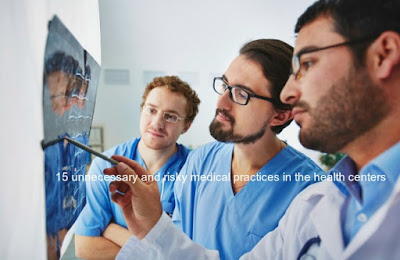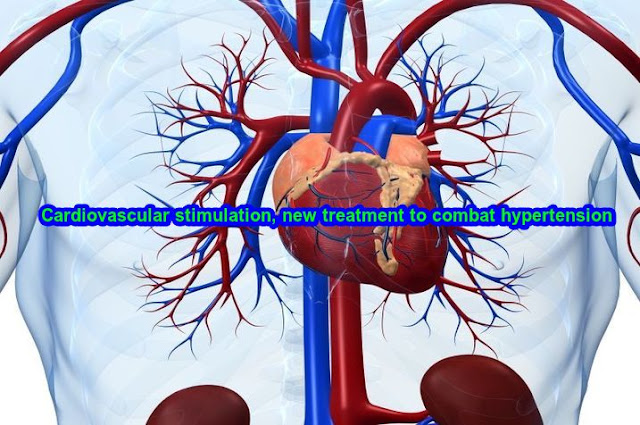 |
| 15 unnecessary and risky medical practices in the health centers |
Showing posts with label treatment. Show all posts
Showing posts with label treatment. Show all posts
Tuesday, March 7, 2017
15 unnecessary and risky medical practices in the health centers
15 unnecessary and
risky medical practices in the health centers
Beginning next week, all health centers in Spain
will start receiving the material of a campaign launched by the Spanish Society
of Family and Community Medicine (semFYC) to promote best practices, aimed at
avoiding interventions Unnecessary medical and with potential risks, in the
approach of emergency cases.
E is an action framed in the initiative Do not,
since 2014, is developing the semFYC; In the context of the same have already
been made several actions previously, although it is the edition of these
posters that is expected to have greater projection. In fact, this is the first
time that these recommendations have been presented in the form of a reminder
poster focusing on concrete good practices. 15,000 posters have been edited.
To launch the campaign, three of the indications
that were collected in the document 15 Recommendations Not to Do in the
Emergency Room were presented a few months ago in the form of a guide:
In case of a hypertensive urgency, the blood
pressure figures should not be reduced quickly or excessively. Do not prescribe
antibiotics in all cases of exacerbation of chronic obstructive pulmonary
disease and do not perform dipstick in patients with bladder catheter.
"The three recommendations have been selected
in relation to their high prevalence in emergency services," says Ayose
Pérez, coordinator of the Working Group on Urgency and Continued Care of the
semFYC, who emphasizes that "these recommendations - two therapeutic and
the other Diagnostic tests-present a widespread use while having little or no
level of scientific evidence to support continuing this type of praxis. "
The campaign, with great visual component,
emphasizes the recommendation of textual form, accompanied by an image and the
identification of the campaign Do not. This representation fulfills the
objective of showing the reminder with simplicity and effectiveness, so that,
through the texts that appear in the poster's foot and a QR system, health
professionals can contrast the scientific basis of the recommendation, as well
as the Reference medical bibliography for each of the indications.
"At the bottom of the campaign, the idea prevails
that, with a complete and extensive training base, the family doctor covers a
broad spectrum of care activities ranging from disease prevention, chronic
patient care, emergencies, Or palliative care, up to and including health
management. All this makes us the main actors of our health system, so the
campaign Not Recommendations of Our Scientific Society is also a genuine
commitment to quality, to the patient and to the efficiency of the health
system, "says the president of the SemFYC, Salvador Tranche.
Following the line of the documents Do not do that
previously has edited the Spanish Society of Family and Community Medicine,
semFYC, the implementation of this campaign through posters "want to claim
that not doing harm is an essential ethical requirement to be kept in mind In
the health environment, which must be critical to those medical actions that
are carried out because they have always been done, despite their little
scientific evidence, and even with evidence against, "explains Ayose Pérez,
coordinator of the Group of Work of Emergencies and Continued Care of the
semFYC.
In this sense, the Do not do documents, as Ayose
Pérez argues, "allow us to question 'custom' and improve our profession,
to be critical with each experience and to rely on evidence-based
medicine."
This idea also prevails in the last edition of the
Do not Do Recommendations published by semFYC in the semfyc-No-do-vertical that
became the focus of interest in the urgencies given that "if not doing
harm is an essential ethical requirement that must be taken Present in any
health environment, it is even more so in urgent care where, in most cases,
rapid decisions must be made, in patients with a high degree of complexity and
who involve a vital commitment or risk of permanent serious sequelae, for Which,
in many cases, not making or performing a certain prescription or diagnostic
test will be a real benefit to our patient, "says the coordinator of the
Working Group on Emergency and Continued Care of the semFYC.
It should be noted that semFYC, prior to the launch
of this campaign defined as "a component of memory and visual
support", has issued three consultation documents in a booklet format with
No Do recommendations. The first, Recommendations Not to Do, was published in
2014; The second, Recommendations Not to Do, part 2, was published in 2015 and
the third, 15 Recommendations Not to Do in Emergencies, was presented in 2016.
The semFYC is the federation of the 17 Societies of
Family and Community Medicine that exist in Spain and groups more than 20,000
family doctors. The specialty of Family Medicine seeks to improve the health
care of users of the Public Health of the National Health System through a
closer attention to people, their family and their community environment.
Cardiovascular stimulation, new treatment to combat hypertension
Cardiovascular
stimulation, new treatment to combat Hypertension
High blood pressure is a disease that affects a high
percentage of the population (40% of adults in Spain and 30% of the world
population). It consists of raising blood pressure. Although not a particularly
serious condition, it can become a much worse disease if medical advice is
ignored.
One of the treatments that in recent years is being
used to combat hypertension is cardiovascular stimulation. It is a device that
through synchronized external counter pulsation favors the production of nitric
oxide. Nitric oxide is a molecule the body produces to help its 50 billion
cells in their vital functions.
"This type of treatment helps greatly to
alleviate the effects of high blood pressure. It is also totally painless and
non-invasive, "says Carlos Santelli, a Revitacell Clinic doctor.
There is evidence of a defect in the production of
nitric oxide as a cause of vascular diseases including hypertension. As early
as 1998 Dr. Louis Ignarro received the Nobel Prize in Medicine for creating a
formula for reproducing nitric oxide to regulate blood pressure. Currently
cardiovascular stimulation is used to increase the amount of nitric oxide in
the body and thus combat vascular problems.
"Nitric oxide functions as a potent vasodilator
for peripheral vascular tone to be maintained," says Dr. Santelli. In
addition, this component maintains the elasticity of all muscles, veins,
arteries and heart.
The main purpose of this type of treatment against
arterial hypertension is in the patient to minimize the possible risks of cardiovascular
morbidity and mortality.
"As the relationship between cardiovascular
risk and blood pressure is continuous, with no lower threshold, the goal of
antihypertensive therapy should be to restore blood pressure values defined
as optimal," concludes the doctor.

















